Centauri Dreams
Imagining and Planning Interstellar Exploration
Hitchhiker to the Outer System
At the Jet Propulsion Laboratory in Pasadena, Masahiro Ono has been using supercomputer simulations to model a new way of moving between small bodies in the Solar System. We’ve had a demonstration in the last few years of what ion propulsion can do to enable orbital operations at one asteroid (Vesta) followed by a journey to another (Ceres) and orbital insertion there. But Ono is looking at ways to simplify the process of asteroid and comet rendezvous that replaces the need for propellant during the orbital insertion and landing phases.
Call it Comet Hitchhiker. “Hitchhiking a celestial body is not as simple as sticking out your thumb, because it flies at an astronomical speed and it won’t stop to pick you up. Instead of a thumb, our idea is to use a harpoon and a tether,” says Ono, who presents the idea today at the American Institute of Aeronautics and Astronautics SPACE conference in Pasadena. The work has intriguing implications for our investigations of the Kuiper Belt and outer system.
Ono’s method uses reusable tethers that, as this JPL news release explains, are best understood by means of a deep sea fishing analogy. As when a fisherman, having hooked a fish, releases more line under moderate tension, letting the line play out but gradually braking, so a spacecraft would sling an extendable tether toward a comet or asteroid, with a harpoon attached to the tether acting as the ‘hook.’ The spacecraft then releases tether even as it applies a regenerative brake to harvest kinetic energy as the craft accelerates.
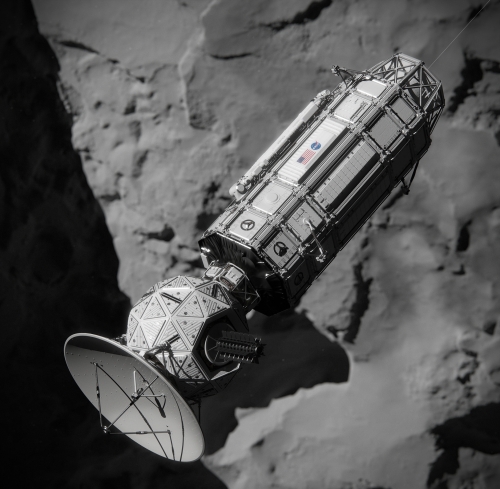
Image: Comet Hitchhiker, shown in this artist rendering, is a concept for orbiting and landing on small bodies. Credit: NASA/JPL-Caltech/Cornelius Dammrich.
According to Ono’s simulations, a long enough line allows Comet Hitchhiker to match velocity with the target gradually, after which it begins to reel in the tether for a gentle descent. The idea, Ono believes, works in both directions. After conducting its investigations at the object in question, the spacecraft uses harvested energy to retrieve the tether and accelerate away to another object. The potential for studying five to ten asteroids in a single mission is on the table.
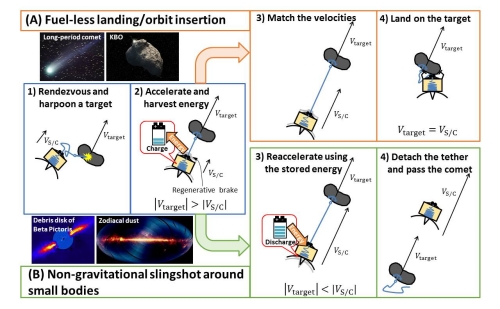
Image: The Comet Hitchhiker concept. Credit: Masahiro Ono.
The question, of course, is what kind of tethers could handle both the harpoon impact on the surface and the demands of the subsequent maneuver. To study the prospects, Ono and colleagues have been using a mathematical formulation they call the Space Hitchhike Equation, relating the specific strength of the tether, the mass ratio between spacecraft and tether, and the needed velocity change to make the operation work. Enormous tension will be placed on the tether and heat will be generated by the rapid decrease in speed for orbit and landing.
The hitchhike maneuver would require a tether anywhere from 100 to 1000 kilometers long. Ono is reporting that a velocity change of 1.5 kilometers per second can be managed with existing materials like Zylon and Kevlar, but a 10 kilometer per second velocity change would be possible with future technologies like carbon nanotubes and a diamond harpoon. The latter would give us sufficient delta-V to land on or orbit long-period comets or Kuiper Belt Objects, objects for which current methods only offer us flyby options.
Consider, too, the prospects for non-gravitational slingshots around small bodies, as Ono reports in a description of this work:
A comet hitchhiker can obtain ~5 km/s of additional delta-V by utilizing just 25% of the harvested energy for reeling in the tether and/or driving electric propulsion engines. The tether is detached from the target after the desired delta-V is obtained. Our concept enables to design a fast trajectory to a wide range of destinations in the Solar System by taking full advantage of the high relative velocity, abundance, and orbital diversity of small bodies. For example, by hitching a comet with q=0.5 AU, a comet hitchhiker can reach the current orbital distance of Pluto (32.6 AU) in 5.6 years and that of Haumea (50.8 AU) in 8.8 years.
With the European Space Agency’s Rosetta spacecraft continuing operations around Comet 67P/Churyumov-Gerasimenko and ongoing work with Dawn at Ceres, will Comet Hitchhiker open up future options for studying multiple small bodies in a single mission? Much depends on what happens next. Ono and team plan to do further modeling and experiments using materials simulating a comet or asteroid surface. Their work is being supported by a Phase 1 study from the NASA Innovative Advanced Concepts (NIAC) program. Ono’s description of Comet Hitchhiker is available at the NIAC site.

A Statistical Look at Panspermia
Would panspermia, the idea that primitive life can spread from star to star, be theoretically observable? Henry Lin and Abraham Loeb (both associated with the Harvard-Smithsonian Center for Astrophysics) believe the answer is yes. In a paper accepted for publication in Astrophysical Journal Letters, the duo make the case that panspermia would create statistical correlations regarding the distribution of life. Detecting biosignatures in the atmospheres of exoplanets may eventually allow us to apply statistical tests in search of these clustering patterns. If panspermia occurs, the paper argues, we can in principle detect it.
“In our theory,” says Lin, “clusters of life form, grow, and overlap like bubbles in a pot of boiling water.” The paper argues that future surveys like TESS (Transiting Exoplanet Survey Satellite) could be an early step in building the statistical database needed. TESS could detect hundreds of terrestrial-class explanets, some of whose atmospheres will be subject to study by ground-based observatories and instruments like the James Webb Space Telescope. Next-generation instruments will do more, allowing us to look for detailed spectral signatures like the ‘red edge’ of chlorophyll or, conceivably, the pollution of a technological society.
Moreover, SETI searches at radio or optical wavelengths could produce detections that eventually allow us to test for clustering, the point being that life that arises by spreading through panspermia should exhibit more clustering than life that arises spontaneously. The statistical models that Lin and Loeb develop in the paper have observable consequences that could begin to turn up as we expand our investigations into astrobiology. Think of Lin’s ‘bubbles’ of life that grow and overlap, or consider the spread of life from host to host in terms of the spread of an epidemic. We may eventually have the data to confirm the idea. From the paper:
In a favorable scenario, our solar system could be on the edge of a bubble, in which case a survey of nearby stars would reveal that ? 1/2 of the sky is inhabited while the other half is uninhabited. In this favorable scenario, ? 25 targets confirmed to have biosignatures (supplemented with 25 null detections) would correspond to a 5? deviation from the Poisson case [a probability distribution], and would constitute a smoking gun detection of panspermia.

Image: The center of the Milky Way as seen from the mountains of West Virginia. Is there life out there, and if so, does it arise spontaneously, or spread from star to star? Credit: Forest Wander.
The transition between an uninhabited to an inhabited galaxy occurs much faster through panspermia than through a gradual buildup of life arising spontaneously in random areas. There is even a Fermi implication here — if life started at roughly the same time everywhere, then we would expect fewer advanced civilizations at the present time than if life started at random times throughout the universe (the authors note that the Drake equation is based on the assumption that life arises independently everywhere, which contradicts efficient panspermia).
The paper continues:
A more generic placement would increase the number of required detections by a factor of a few, though an unusual bubble configuration could potentially reduce the number of required detections. It should be noted that the local environment of our solar system does not reflect the local environment ? 4 Gyr ago when life arose on earth, so the discovery of a bubble surrounding earth should be interpreted as the solar system “drifting” into a bubble which has already formed, or perhaps the earth seeding its environment with life.
The paper notes that any species capable of panspermia will have enormous fitness advantages as it can move from one stellar host to another. Lin and Loeb believe that if panspermia is not viable and Earth is the only inhabited planet, interstellar travel may lead to colonization of the galaxy. In this case panspermia models may still be relevant: A culture using starships may provide the opportunity for primitive forms of life including disease and viruses to spread efficiently, with the same processes of growth and diffusion occurring throughout space.
Can primitive life, then, spread on its own, or does it need intelligent life to create the conditions for its growth outward? Either way, we see life expanding in all directions, producing what this CfA news release calls “a series of life-bearing oases dotting the galactic landscape.” If such patterns exist, finding them will depend upon how quickly life spreads, for any ‘bubbles’ or ‘oases’ could be lost in the regular flow of stellar motion and redistribution about the galaxy. But whatever the biological mechanisms of panspermia might be, it is in principle detectable.
The paper is Lin and Loeb, “Statistical Signatures of Panspermia in Exoplanet Surveys,” accepted for publication at Astrophysical Journal Letters (preprint).

A KBO Target for New Horizons
What we’ll eventually want is a good name. 2014 MU69 is the current designation for the Kuiper Belt Object now selected as the next destination for New Horizons, one of two identified as possibilities, and the one the New Horizons team itself recommended. Thus we have a target — a billion and a half kilometers beyond Pluto/Charon — for the much anticipated extended mission, but whether that mission will actually occur depends upon NASA review processes that are not yet complete. Still, the logic of putting the spacecraft to future use is hard to miss, as John Grunsfeld, chief of the agency’s Science Mission Directorate, is the first to note:
“Even as the New Horizon’s spacecraft speeds away from Pluto out into the Kuiper Belt, and the data from the exciting encounter with this new world is being streamed back to Earth, we are looking outward to the next destination for this intrepid explorer. While discussions whether to approve this extended mission will take place in the larger context of the planetary science portfolio, we expect it to be much less expensive than the prime mission while still providing new and exciting science.”
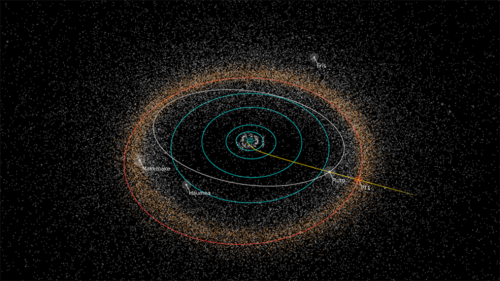
Image: Path of NASA’s New Horizons spacecraft toward its next potential target, the Kuiper Belt object 2014 MU69, nicknamed “PT1” (for “Potential Target 1”) by the New Horizons team. Although NASA has selected 2014 MU69 as the target, as part of its normal review process the agency will conduct a detailed assessment before officially approving the mission extension to conduct additional science. Credit: NASA/Johns Hopkins University Applied Physics Laboratory/Southwest Research Institute/Alex Parker.
We wind up with a situation where action precedes future decision. While the extended mission proposal will not be turned in to NASA until next year, the spacecraft can’t delay its preparations for a rendezvous with 2014 MU69 — trajectory changes factor into the equation. New Horizons, as this JHU/APL news release points out, will perform four maneuvers in late October and early November to make the necessary course changes for a January 1, 2019 flyby.
In anticipation of probable work beyond Pluto/Charon, New Horizons has the necessary hydrazine for a KBO intercept, and we’ll be able to monitor its communications and data return for years to come. Researchers had their eye on the kind of primitive object out of which dwarf planets like Pluto themselves may have been made, and the new target fits the bill.
“2014 MU69 is a great choice because it is just the kind of ancient KBO, formed where it orbits now, that the Decadal Survey desired us to fly by,” said New Horizons Principal Investigator Alan Stern, of the Southwest Research Institute (SwRI) in Boulder, Colorado. “Moreover, this KBO costs less fuel to reach [than other candidate targets], leaving more fuel for the flyby, for ancillary science, and greater fuel reserves to protect against the unforeseen.”
As to that new name, 2014 MU69 is already being called PT1, for ‘potential target 1,’ but will want something a bit more muscular, and certainly more poetic. You’ll recall how tricky it was to find a KBO for this encounter in the first place (see, for example, New Horizons: Potential KBO Targets Identified). Among those found after the search began in 2011, none were within range of the craft’s fuel supply. It took the Hubble Space Telescope to discover, in the summer of 2014, the two prime candidates. And it’s easy to understand Alan Stern’s enthusiasm. 2014 MU69. at about 45 kilometers across, is ten times times bigger than the average comet and a thousand times more massive, even if it’s about 1/10,000th the mass of Pluto.
It wasn’t that long ago — in August of 1992, to be specific — that David Jewitt and Jane Luu discovered the first trans-Neptunian object beyond Pluto/Charon, one that gave rise to the term ‘cubewano,’ named after the latter part of its designation, (15760) 1992 QB1. Jewitt and Luu liked the name ‘Smiley’ for the KBO, but there is already an asteroid with that name (1613 Smiley), so like 2014 MU69, even the first identified KBO could use a new monicker. Whatever we call it, 2014 MU69 should give us a look at the early days of Solar System formation some 4.6 billion years ago, preserved by distance and the outer system deep freeze.

The Prime Directive – A Real World Case
Trying to observe but not harm another civilization can be tricky business, as Michael Michaud explains in the article below. While Star Trek gave us a model for non-interference when new cultures are encountered, even its fictional world was rife with departures from its stated principles. We can see the problem in microcosm in ongoing events in Peru, where a tribal culture coming into contact with its modern counterparts raises deeply ambiguous questions about its intentions. Michaud, author of Contact with Alien Civilizations (Copernicus, 2007), draws on his lengthy career in the U.S. Foreign Service to frame the issue of disruptive cultural encounter.
By Michael A.G. Michaud
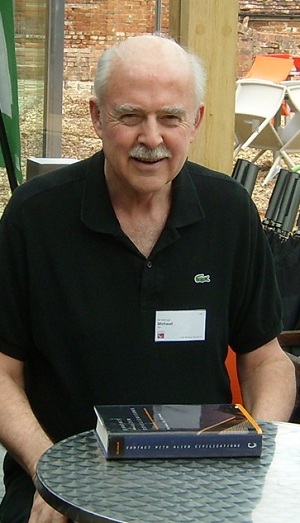
Science fiction fans all know of the Prime Directive, usually described as avoiding contact with a less technologically advanced civilization to prevent disruption of that society’s development. In a 1968 Star Trek episode, the directive was explicitly defined: “No identification of self or mission. No interference with the social development of said planet. No references to space or the fact that there are other worlds or civilizations.” Another version of the Prime Directive forbade introducing superior knowledge or technology to a society that is incapable of handling such advantages wisely.
Commentators have pointed out many violations of the directive in the Star Trek series (and in other science fiction programs). The Enterprise crew sometimes intervened to prevent tragedy or promote positive outcomes. De facto, observance of the Prime Directive was scenario-dependent.
Star Fleet personnel sometimes used hidden observation posts or disguises to watch or interact with natives. In one episode, Captain Kirk left behind a team of sociologists to help restore an alien society to a “human form.” At the other extreme, the Prime Directive was interpreted as allowing an alien civilization to die.
Star Trek was not the first source of a prime directive. In Olaf Stapledon’s 1937 novel Star Maker, superior beings take great care to keep their existence hidden from “pre-utopian” primitives so that the less advanced beings will not lose their independence of mind.
A recent article in Science reminds us that the practical application of such a principle in a real contact situation on Earth is riddled with complications and uncertainties. The government of Peru has been debating whether or not to make formal contact with a tribal people living in the Peruvian Amazon, sighted frequently over the past year.
Peruvian policy has been to avoid contact with isolated tribes and to protect them from intruders in their reserves. In practice, this policy has been difficult to enforce. Tour operators sell tickets for “human safaris;” some tribespeople loiter on the river bank, letting themselves be seen. One anthropologist said that they were deliberately seeking to interact with people on the river.
There is a dark side to tribal behavior. Some of the tribals raided a nearby village for supplies, killing two villagers.
The tribespeoples’ conflicting actions have left their desires unclear. Though some have sought goods, shooting arrows at Peruvians suggests that they do not want contact.
Peru’s government wants to train local people to avoid isolated tribes unless those tribes make the first move. The plan is to increase patrols, discourage raids, and make contact with the tribespeople only if they show a willingness for conversation.
This is termed “controlled contact.” Two anthropologists proposed in a Science editorial that “a well-designed contact can be quite safe,” but another group accused them of advocating a dangerous and misleading idea.
One of the proposed explanations for our non-detection of alien intelligences is the Zoo Hypothesis, which claims that more advanced civilizations deliberately avoid making themselves known to us so as not to disturb humankind’s autonomous development. Others suggest practical reasons for such apparently altruistic behavior. As Robert Rood put it, the only thing we could offer them is new ideas. Their intervention would stop our development.
Much of this debate has been driven by guilt over the impact of Western colonial powers on other Earthly societies. Star Trek and other science fiction treatments used interactions with aliens as allegories for our own world.
Some argue that external cultural influences can be positive. What we call Western Civilization was the product of many forces that came from outside. Europe’s major religions came from the Middle East. Others see Westernization as a threat that must be resisted, notably in the Islamic world.
If we ever find ourselves in contact with an alien civilization, one of the parties is likely to be more scientifically and technologically advanced than the other. Will the more powerful intelligences observe some sort of Prime Directive? That may be more complicated than many humans believe.
——-
References
Andrew Lawler, “Mashco Piro tribe emerges from isolation in Peru,” Science 349 (14 August 2015), 679.
“Prime Directive,” Wikipedia, accessed 21 August 2015.
Michael A.G. Michaud, Contact with Alien Civilizations, Copernicus (Springer), 2007, 237.

Back to the Ice Giants?
As data return from New Horizons continues, we can hope that an encounter with a Kuiper Belt Object is still in its future. But such an encounter will, like the flyby of Pluto/Charon itself, be a fleeting event past an object at huge distance. Our next chance to study a KBO might take place a bit closer in, and perhaps we’ll be able to study it with the same intense focus that Dawn is now giving the dwarf planet Ceres. How about an orbiter around Neptune, whose moon Triton is thought by many to be a KBO captured by the ice giant long ago?
The thought is bubbling around some parts of NASA, and was voiced explicitly by the head of the agency’s planetary science division, Jim Green, at this week’s meeting of a working group devoted to missions to the outer planets. Stephen Clark tackles the story in Uranus, Neptune in NASA’s Sights for a New Robotic Mission, which recounts the basic issues now in play. What comes across more than anything else is the timescale involved in putting together flagship missions, multi-billion dollar efforts on the order of our Cassini Saturn orbiter.
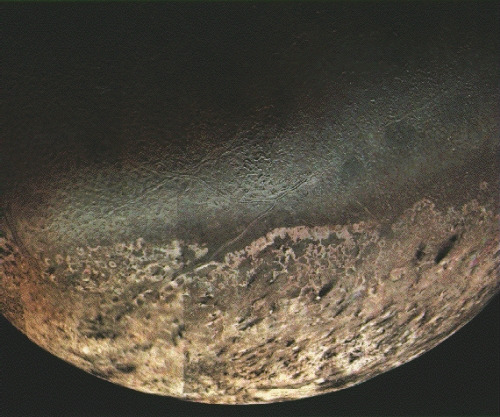
Image: Neptune’s moon Triton, as seen by Voyager 2. Credit: NASA/JPL.
Right now Europa is the more immediate priority when it comes to outer planets work, and for good reason, since NASA has already approved a probe to the Jovian moon. Here we’re talking about 2022 as the earliest possible launch date for a spacecraft that would orbit Jupiter and perform repeated close flybys of Europa, a world we need to study close-up because of the evidence for a liquid water ocean beneath its crust and the possibility of life there. Whether such a probe actually flies as early as 2022 is problematic, and so is the launch vehicle, which in a perfect confluence of events could conceivably be NASA’s powerful Space Launch System.
I say ‘perfect’ confluence because the muscular SLS, if it lives up to expectations, would offer more robust mission options not just for Europa but for all the outer planets. Before any of that happens, of course, we have to build and fly SLS. While issues like that remain fluid, the current investigations into still later missions to Uranus and Neptune would seem to be premature, but they have to be, given not just the scientific but the bureaucratic issues involved. The JPL study on Uranus and Neptune ponders missions that could be launched probably in the 2030s, with the expectation of coming up with a mission design that could be used at both of the ice giants, although cheaper options will also be considered.
In any case, space missions begin with preliminary studies that launch a process feeding into the decadal surveys that set priorities for the next ten years of research. The last such survey, coming out of the National Research Council in 2011, gave particular weight to Mars sample return and the Europa probe. Getting an ice giant mission into the next decadal survey is no sure thing, given a strong case to be made for further investigation of Titan, and Clark notes that Venus is also likely to gain support.
So it’s early days indeed for Uranus and Neptune, but conceptual studies are a critical first step toward eventual approval. It’s daunting, and a bit humbling, to realize that if all goes well — if the bureaucratic gauntlet can be successfully run all the way through myriad technical studies and peer review into the budgeting phase and beyond — any mission to the ice giants will arrive half a century after Voyager 2 made our first and only encounters with these worlds. A return with orbiters would give us the opportunity to evaluate the major differences between the ice giants and the larger gas giants around which we’ve been able to conduct orbital operations.
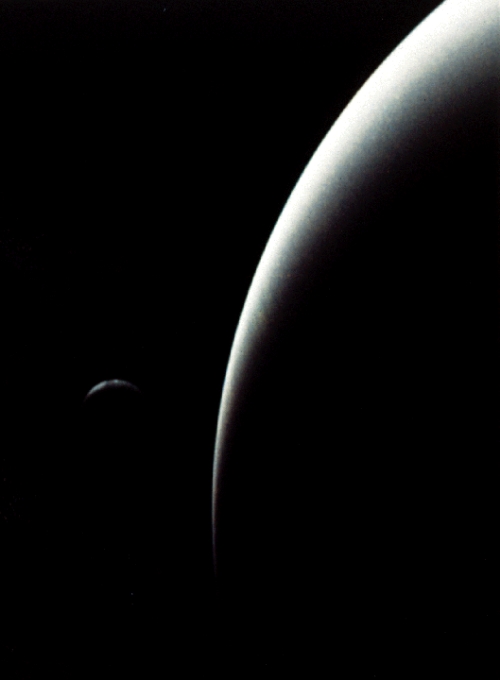
Image: Voyager 2 image of the crescents of Neptune and Triton taken on its outbound path, about 3 days after closest approach. The picture is a composite of images taken from a distance of almost 5 million km as Voyager 2 flew southward at an angle of 48 degrees to the ecliptic after its encounter with Neptune, the final encounter of its journey through the solar system. Credit: NASA/JPL.
It’s often said that we want missions that can be flown within the lifetime of the people who designed them, which is an understandable though mistaken thought. If you were a planetary scientist, would you turn down the chance to work on a Uranus/Neptune mission design even if you were unlikely to see it arrive? Clark quotes William McKinnon (Washington University, St. Louis) on the ice giant probe concept: “An ice giant mission, presumably an orbiter, is, alas, over the horizon as far as my lifespan is concerned, so I salute those who will live to see it!”
Which is what we do, looking forward to the next generation if we can’t complete a task within our own. On the individual level we can say little about the details of our own mortality, so there is no guarantee of survival to mission completion even for relatively nearby targets. We keep building spacecraft anyway. In the case of the outer system, we take decades to design, approve, build and fly spacecraft not in the name of individual ego but of a shared humanity.
The interstellar effort places this principle in even starker terms, for in terms of the physics we understand today, missions to another star will be a matter of, at best, decades and perhaps centuries of flight time. We can hope that rather than turning away from this effort, we continue to probe it with better designs, continuing missions and a determination to keep exploring.

Sharper Views of Ceres
The mapping of Ceres continues at a brisk pace. The Dawn spacecraft is now operating at 1470 kilometers from the surface, taking eleven days to capture and return images of the entire surface. As this JPL news release points out, each eleven day cycle consists of fourteen orbits, so we’re accumulating views of this formerly faint speck in unprecedented detail. Within the next two months, Dawn will map Ceres — all of Ceres — six times.
Have a look, for example, at this view of one of Ceres’ more intriguing surface features. Taken by Dawn’s framing camera on August 19, the image has a resolution of 140 meters per pixel.
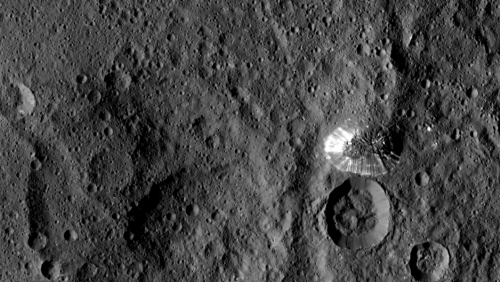
Image: NASA’s Dawn spacecraft spotted this tall, conical mountain on Ceres from a distance of 1,470 kilometers. The mountain, located in the southern hemisphere, stands 6 kilometers high. Its perimeter is sharply defined, with almost no accumulated debris at the base of the brightly streaked slope. Credit: NASA/JPL-Caltech/UCLA/MPS/DLR/IDA.
The naming of surface features also continues, the image below showing a mountain ridge at lower left that’s in the center of Urvara crater. The 163-kilometer Urvara takes its name from an Indian and Iranian deity of plants and fields.
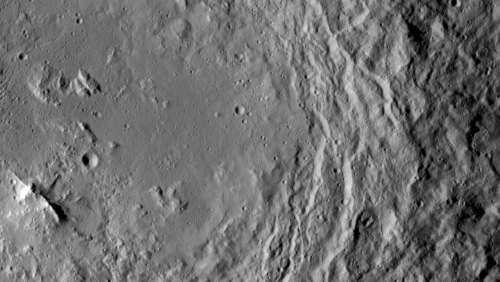
And below we have Gaue crater at the bottom of the frame, named after a Germanic goddess of the harvest.
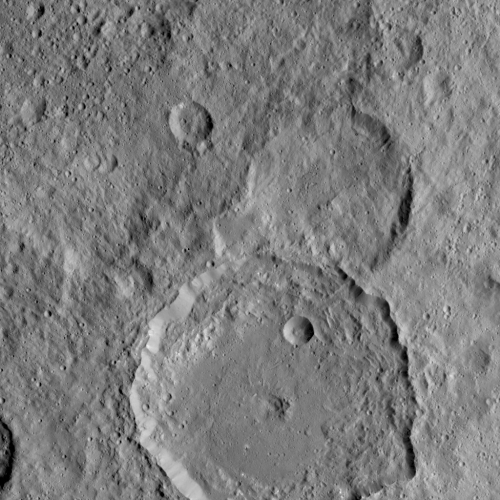
JPL’s Marc Rayman, chief engineer for Dawn and mission director, notes the continuing success of the mapping operation:
“Dawn is performing flawlessly in this new orbit as it conducts its ambitious exploration. The spacecraft’s view is now three times as sharp as in its previous mapping orbit, revealing exciting new details of this intriguing dwarf planet.”
How to get views as good as Dawn is currently sending without actually making the trip? Rayman points out in his latest Dawn Journal entry that a telescope 217 times the diameter of Hubble could provide the same images, which makes a click on the Ceres image gallery all the more preferable. At its current height, Dawn’s camera sees a square 140 kilometers to the side, which is less than one percent of the almost 2.8 million square kilometer surface of the world.
Ahead for Dawn is a set of six mapping cycles (the images above come from the first of these), with changes in camera angle providing stereo views that will help us understand the topography. As it records infrared and visible spectra of the terrain, Dawn is also returning a radio signal that will help researchers probe the dwarf planet’s gravitational field, a key to the distribution of mass inside the object. At 308 million kilometers from Earth, Dawn’s radio signals take 34 minutes to make the round trip. Remember that all this is being accomplished despite the earlier failure of two of the craft’s reaction wheels, a problem in spacecraft orientation that has been surmounted by ground controllers and will not affect the outcome of the mission.


